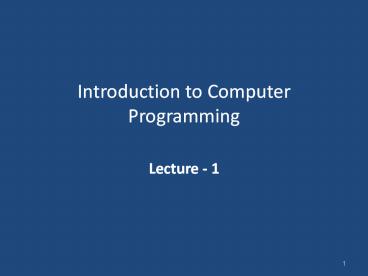Introduction to Computer Programming - PowerPoint PPT Presentation
1 / 14
Title:
Introduction to Computer Programming
Description:
Introduction to Computer Programming Lecture - 1 * Computer Programming:- Computer programming is the process of designing, writing, testing, and maintaining the ... – PowerPoint PPT presentation
Number of Views:102
Avg rating:3.0/5.0
Title: Introduction to Computer Programming
1
Introduction to Computer Programming
- Lecture - 1
2
Computer Programming-
- Computer programming is the process of designing,
writing, testing, and maintaining the source
code of computer programs.
3
Computer Program-
- A computer program is a sequence
of instructions written to perform a specified
task for a computer. - A computer requires programs to function.
- Computer software is the collection of computer
programs that provide the instructions telling a
computer what to do. - Programs are written in a programming language,
example C language
4
Program consists of-
- Keywords Keywords are the predefined elements of
a program. They may only be used for their
intended purpose. - Defined Symbols Elements defined by the
programmer. They are symbolic names that refer to
variables. - Operators and Operands Operators perform
operations on one or more operands. An operand
is usually a piece of data, like a number. - For example a b
- --- Operator
- a, b --- Operands
- Syntax and Semantic Rules followed while
constructing a program. Syntax dictates how key
words and operators must be used.
5
What is a Programmer?
- A programmer or computer programmer or coder is
the one who writes computer programs to develop
computer software. - Programmers use a Programming language to write
the computer programs.
6
Programming Languages-
- Computer programming language can be classified
into two major categories - Low level
- Low level programming languages are close to the
machine(computer hardware). - They doesnt need compiler or interpreter for
execution of a program. - Example 1 - Machine Language
(Binary language 0s and 1s) 2 -
Assembly Language (OPCODEs and MNEMONICS)
7
Continued-
- 2-High Level Languages (HLL)
- High level programming languages are close to the
User that is machined independent. - They need compiler or interpreter for execution
of a program. - Example 1 - Visual Basic
2 - Pascal 3 - Java 4 C,
C and many more.
8
Program Execution?
- Each programming language is associated with a
Compiler or/and Interpreter. - Compilers and Interpreters are needed to execute
or run the program and to get the result.
9
What is Compiler?
- A Compiler is a program that translates a
high-level language into a low-level.The
compiler takes the file that you have
written(Source code) and produces another
file(Object code) from it.The Source code is
user understandable and Object Code is Machine
Understandable
10
Compiler
11
What is Interpreter?
- A Compiler is also a program that translates a
high-level language into a low-level. - It does it at the moment the program is run.
- It takes the program, one line at a time, and
translates each line before running it It
translates the first line and runs it, then
translates the second line and runs it etc.
12
Interpreter
13
Software Engineering
Software engineering (SE) is -the profession conc
erned with specifying, designing, developing and
maintaining software applications by
applying technologies.
14
FIVE basic phases of Software Development Life
Cycle -
- Requirement and Analysis
- System Design
- Coding and Implementation
- Integration and Testing
- Deployment and maintenance































